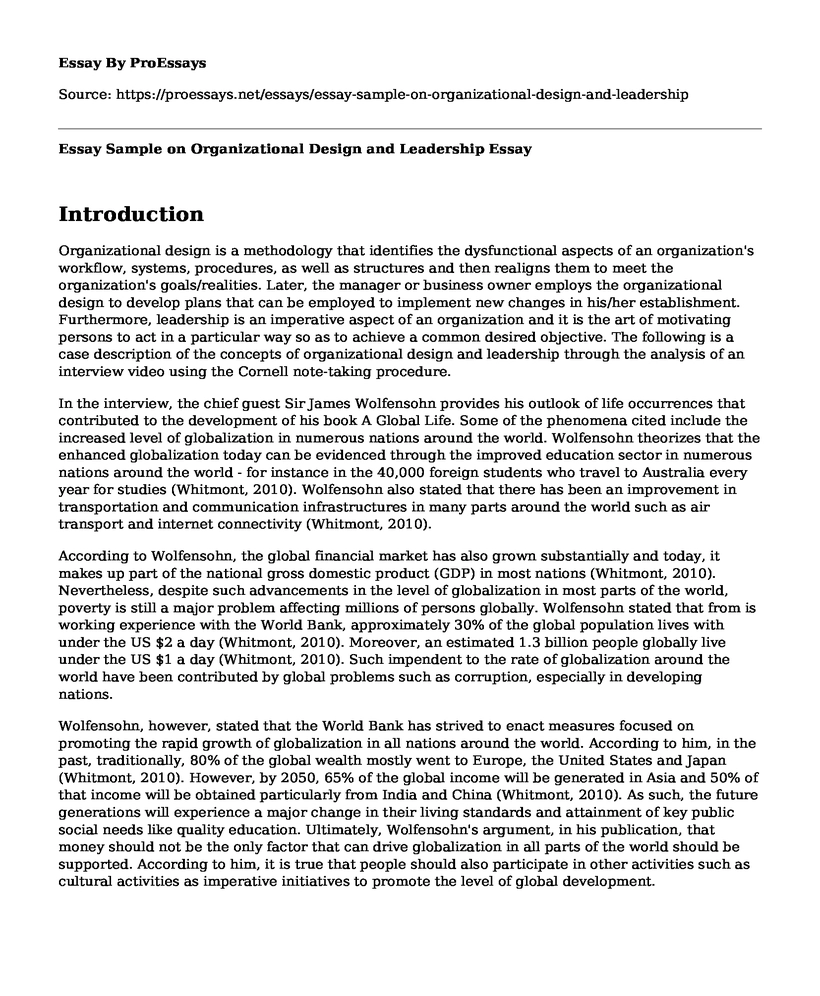Introduction
Organizational design is a methodology that identifies the dysfunctional aspects of an organization's workflow, systems, procedures, as well as structures and then realigns them to meet the organization's goals/realities. Later, the manager or business owner employs the organizational design to develop plans that can be employed to implement new changes in his/her establishment. Furthermore, leadership is an imperative aspect of an organization and it is the art of motivating persons to act in a particular way so as to achieve a common desired objective. The following is a case description of the concepts of organizational design and leadership through the analysis of an interview video using the Cornell note-taking procedure.
In the interview, the chief guest Sir James Wolfensohn provides his outlook of life occurrences that contributed to the development of his book A Global Life. Some of the phenomena cited include the increased level of globalization in numerous nations around the world. Wolfensohn theorizes that the enhanced globalization today can be evidenced through the improved education sector in numerous nations around the world - for instance in the 40,000 foreign students who travel to Australia every year for studies (Whitmont, 2010). Wolfensohn also stated that there has been an improvement in transportation and communication infrastructures in many parts around the world such as air transport and internet connectivity (Whitmont, 2010).
According to Wolfensohn, the global financial market has also grown substantially and today, it makes up part of the national gross domestic product (GDP) in most nations (Whitmont, 2010). Nevertheless, despite such advancements in the level of globalization in most parts of the world, poverty is still a major problem affecting millions of persons globally. Wolfensohn stated that from is working experience with the World Bank, approximately 30% of the global population lives with under the US $2 a day (Whitmont, 2010). Moreover, an estimated 1.3 billion people globally live under the US $1 a day (Whitmont, 2010). Such impendent to the rate of globalization around the world have been contributed by global problems such as corruption, especially in developing nations.
Wolfensohn, however, stated that the World Bank has strived to enact measures focused on promoting the rapid growth of globalization in all nations around the world. According to him, in the past, traditionally, 80% of the global wealth mostly went to Europe, the United States and Japan (Whitmont, 2010). However, by 2050, 65% of the global income will be generated in Asia and 50% of that income will be obtained particularly from India and China (Whitmont, 2010). As such, the future generations will experience a major change in their living standards and attainment of key public social needs like quality education. Ultimately, Wolfensohn's argument, in his publication, that money should not be the only factor that can drive globalization in all parts of the world should be supported. According to him, it is true that people should also participate in other activities such as cultural activities as imperative initiatives to promote the level of global development.
References
Whitmont, T. (2010). A Global Life by James Wolfensohn. Retrieved from Booktopia: https://www.booktopia.com.au/blog/2010/11/01/a-global-life-by-james-wolfensohn/
Cite this page
Essay Sample on Organizational Design and Leadership. (2022, Nov 22). Retrieved from https://proessays.net/essays/essay-sample-on-organizational-design-and-leadership
If you are the original author of this essay and no longer wish to have it published on the ProEssays website, please click below to request its removal:
- Fred Hampton: I Am a Revolutionary
- Conflict Management for Manager - Course Work Example
- Essay on Shop Beauty Needs at Ulta Beauty: Over 20,000 Products and Services
- Sustainable Development: Protecting Earth and Future Generations - Research Paper
- Essay Sample on Leadership: Numerous Definitions & Controversies
- Decision-Making: Predicting the Future & Making Moral Choices - Essay Sample
- Essay Sample on Leadership: Ethics and Courage, Key Values for Success







